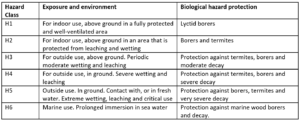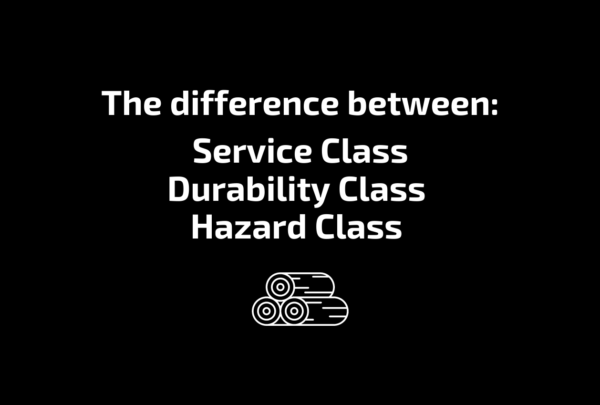It is feasible to require Hazard Class 3 timber for Service Class 2 application using a Durability Class 4 timber with a Class 1 glue.
If this has you confused – and you wouldn’t be alone – this is the blog for you!
Timber species will vary in performance in different applications. Variations are influenced by type of species, level of exposure, system employed or treatment applied – to name a few. It perhaps then goes without saying that some species will perform better than others in certain applications. Importantly, this indicates others should be avoided or detailed in a way that reduces risk of premature failure.
Knowing which species to specify and how to detail for the application involves an understanding of the long term location, chosen specie characteristics and performance, resistance to elements or treatment methods available. For example:
The wide and varied impact on performance can range from one side of the scale to the other. To get the right balance when specifying, it’s important to know the difference between Durability Class, Service Class & Hazard Class. These ‘Classes’ are often confused or intertwined by accident. We hope that the below descriptions will easily help you on your way to successful use of the right timber and the right application.
Service Class is defined within AS 1684 and details the level of weather exposure for a structural element. Knowing this level of exposure will help identify whether the structural timber you have chosen will be exposed to high or low levels of UV degradation, variations in moisture or temperature, speed of degradation, etc. Understanding this will help narrow in on which species is best suited and/or the design and protection measures to employ to obtain longevity – this is of particular concern if the component is also acting under load.
Diagram No.1 is an extract from AS 1684 and shows each Service Class number. The table below outlines the environmental conditions associated with each.


Once you have identified which Service Class your member is positioned in, you may choose to learn how to design/detail that element for longevity. You can read more about designing for Service Class at MASSLAM Design Guide.
Durability Class is defined in AS 5604 as a way of comparing the timbers’ natural ability to resist decay, insect, and marine borer attack in full weather environments, unprotected. While all timber species can easily surpass 50+ years in fully protected environments, each Durability Class gives a ‘good indication’ of how long a chosen species may last in an exposed environment – it’s important to remember that this is a guide at best. The guide does not, however, take into consideration variable influencers on decay such as moisture, weather, geographical location, type of application, exposure to pests, protection measures, maintenance or installation, for example.
In the Durability Class table below, Class 1 is considered the highest durability, while Class 4 is the lowest.
There are two groups of Durability Class – in ground and above ground.

Learn more about durability class at: https://qtimber.daf.qld.gov.au/guides/natural-durability-ratings
A Hazard Class is defined in AS 1604 as ‘the degree of hazard as prescribed in this Standard, for which the timber incorporating the brand has been treated’. In other words, it is a type of preservative treatment that timber has had applied to it, in accordance with procedures listed in the same Australian Standard. These preservative treatments are used to improve the performance of a timber in the stated application.
Hazard Classes range from Hazard Class 1 to Hazard Class 6 and vary in suitability from indoor use with protection against lyctid borer, through to in-ground marine borer protection.

When specifying timber, it’s important to know the difference between Service Class, Durability Class and Hazard Class so you can successfully choose the right timber for the right application. Although these terms are sometimes confused with one another, understanding them can give you a great indication as to which species will perform better than others under certain circumstances. We hope that this blog helps you understand the differences between the three class systems so you can make a more informed decision when choosing a timber for an application.
"*" indicates required fields
